Malware is the silent killer of WordPress websites. Injected into your site’s code, malware lurks undetected, taking up server resources and potentially opening doors for hackers. It can house phishing scams, give cybercriminals access to sensitive data, or be used to spam keywords for black-hat SEO. This can damage your site’s speed, integrity, and online reputation.
Regular malware scanning helps you avoid these issues, as Shield Security PRO’s creator Paul Goodchild explains:
“Malware detection is like a canary in the coal mine. It doesn’t directly protect your site, but it alerts you to vulnerabilities and problems that you already have.”
Identifying malware is vital, but so is swiftly removing it and patching the holes that let it into your site. This article will analyse the most reliable WordPress malware scanners out there, looking into identification, removal, and patching. We’ll also detail any additional security benefits, given a malware scanner can’t protect your site all by itself.
Reliable WordPress malware scanners: Comparing 9 top plugins
Let’s now review the most reliable WordPress malware scanners on the market, leaving no stone unturned in our quest to find the best. Alongside thoroughly testing each product, we’ve considered online reviews, discussion boards, and product descriptions to bring you the definitive user perspective.
We’ve also focused on paid-for versions of these plugins in order to give an accurate comparison, as free versions or trials tend to limit malware scan capabilities. Here we go!
1. Shield Security PRO and MAL{ai}

Obviously we have a bias here, but after weighing up the pros and cons, our top pick for WordPress malware scanning is Shield Security PRO’s built-in scanner.
You can find it under the plugin’s Security Zones menu in your WordPress dashboard. Navigate to Security Zones > Scans & Integrity > WordPress File Scanning to configure and run the scanner.
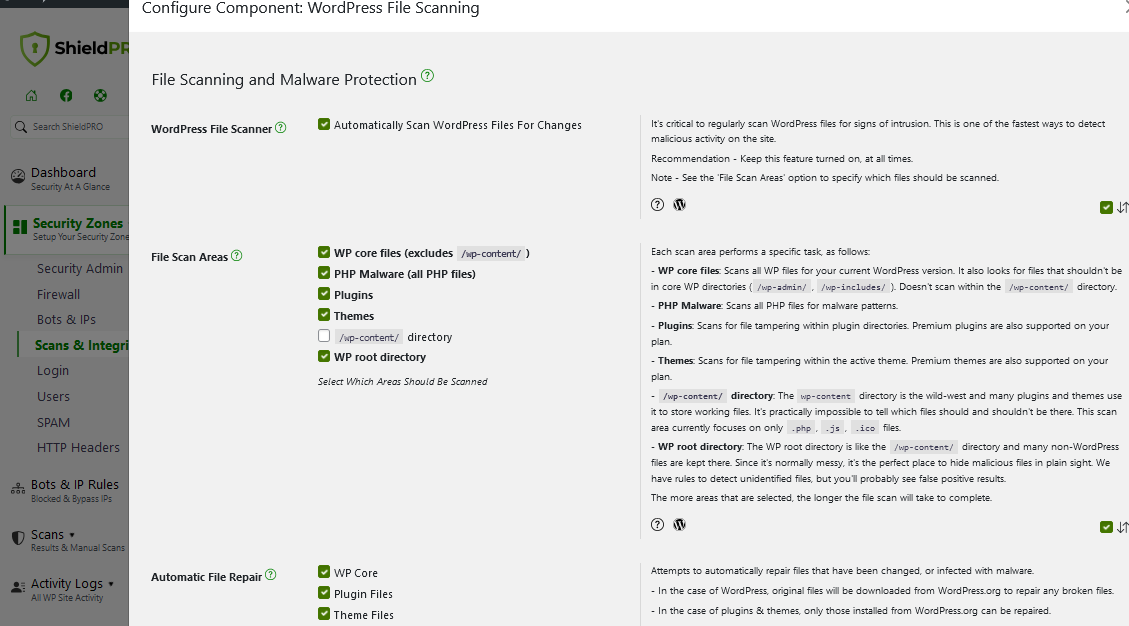
By default, the scanner runs daily, but you can customise the frequency. Shield Security PRO’s malware scanner is powered by MAL{ai}, an artificial intelligence engine that detects PHP malware with remarkable accuracy
MAL{ai} uses adaptive learning to identify malicious code, even if it’s never encountered that specific malware before. In tests, it detected 8 out of 10 brand-new threats. The AI gets smarter with each scan, continuously getting better at detecting malware.
Another advanced feature is MAL{ai}’s ability to evaluate the integrity of plugins and themes. It crowdsources data on what these files should contain, allowing it to pinpoint malware in areas other scanners often miss.
You can configure the plugin to automatically remove detected malware. However, no tool can surgically remove malicious code line-by-line. Instead, Shield Security PRO replaces the entire infected file with a clean version from the WordPress repository. Use this feature cautiously, as it may break customizations.
While the malware scanner is impressive, it’s just one facet of Shield Security PRO’s defence. Other advanced security features include silentCAPTCHA, which blocks malicious bots before they can inject malware, or do any other damage to the site.
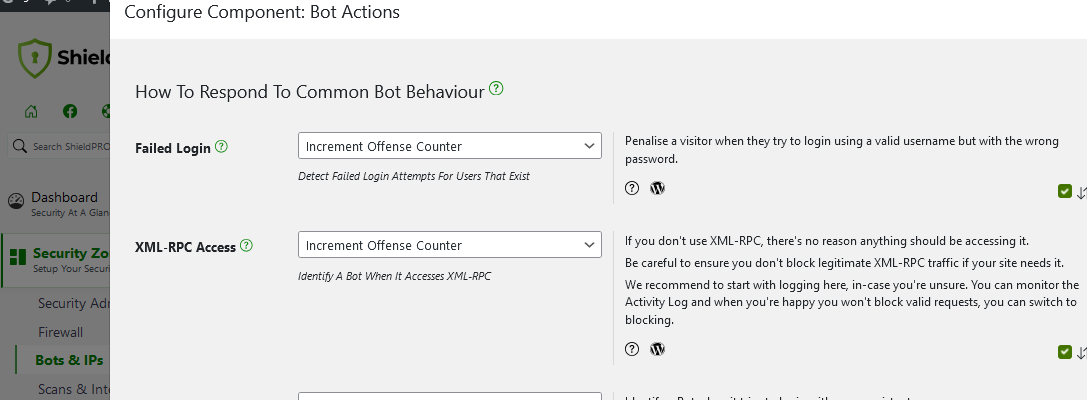
Our plugin has consistently earned 5-star reviews from users who praise its effectiveness and responsive support team. We keep Shield Security PRO regularly updated to counter emerging threats, with recent additions including passkey compatibility, protection against session theft, and a security rules builder for admins to design their own rules.
The MAL{ai} malware scanner is included in Shield Security PRO’s Plus pricing tier and above, available for $149 per year.
2. Sucuri Security
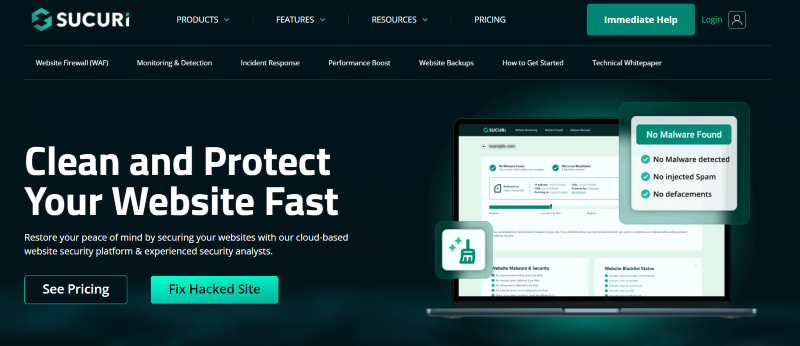
Sucuri offers malware scanning as part of its suite of cyber security tools, which also includes a Web Application Firewall (WAF), DDoS protection, and more. The tool remotely scans a website’s source code for malware, blacklisting status, errors, and outdated software.
It detects malicious code, spam, defacements, and other security issues without requiring server access, and provides reports on attacks blocked and malware found. Sucuri has no automated removal feature, but does offer a manual malware removal service to clean blocked sites.
However, as a remote scanner, it cannot detect server-side threats. Furthermore, some users have reported frustration with incomplete malware removal, or find the service is too slow.
Sending your files to the service for review may also spark privacy concerns for some site owners. Malware scanning is available on all of Sucuri’s paid plans, which start at $199.99 per year.
3. Wordfence
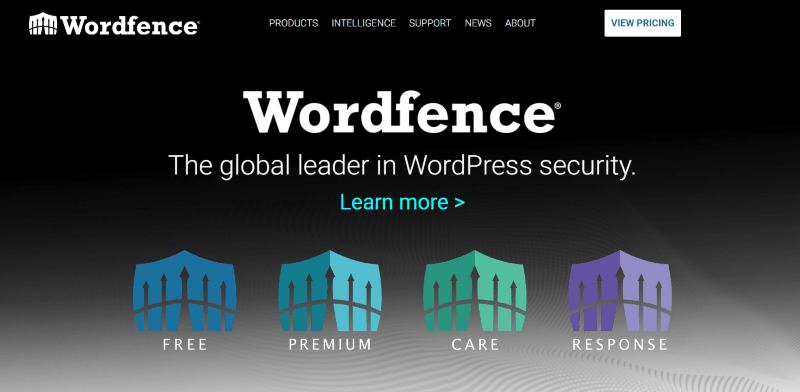
Wordfence is another full-featured security plugin that includes malware scanning as part of its service, alongside login protection, WAF, and other security features.
The plugin scans WordPress core files, themes, and plugins for malware, backdoors, SEO spam, and other security threats. Its scanner checks files against Wordfence’s malware signature database, which includes over 44,000 known malware variants, and compares WordPress files to repository versions to find changes and repair modified files.
❗️Wordfence also claims to have automated cleaning capabilities for removing any malware found. However, whenever you see automated malware removal claims, it’s important to remember what that actually means. Automated malware removal is always done by completely replacing the affected file with a clean version from the WordPress install. This means you can lose customizations if they’re located in the infected file. There is no reliable way to automatically remove individual lines of malware from your site’s code – this can only be done by hand.
The plugin sends regular site health reports. These are detailed and designed to help users understand blocked attacks and potential vulnerabilities. Wordfence is regularly updated, has a large user base, and has a strong reputation in the WordPress community.
However, some reviews report issues with the malware scanner, specifically noting both false positives and a failure to pick up all malware. The tool also has limited effectiveness against new threats that are not already present in its database. Wordfence’s malware capabilities come with the plugin’s Premium pricing tier and above, starting at $119 per year.
4. Jetpack

Jetpack is the official security plugin by Automattic, the company behind WordPress.com and WooCommerce. Jetpack Scan is an automated malware scanning and removal feature included in paid Jetpack plans. It scans your WordPress site’s files daily for malware, vulnerabilities, and security threats.
Scans run on Jetpack’s servers, so they don’t impact your site’s performance. If threats are found, you receive an instant email alert. Jetpack is a user-friendly tool, with additional features like backups and restorations.
However, some users have complained about its impact on performance, and many developers consider it a bit bloated with a lot of features that may not be useful for basic sites. Jetpack Scan also runs automatically once per day on a site, rather than continuously monitoring in real-time. The plugin is available for $119.40 per year.
5. NinjaScanner

NinjaScanner is a lightweight plugin that combines malware scanning with other hardening features. It offers real-time malware detection and can scan files beyond the WordPress installation directory. Users generally consider NinjaScanner effective at identifying threats without significantly impacting site performance, although it has no automated removal feature. The plugin is praised for its minimal resource usage.
However, some users find the interface and setup process a bit technical, which may pose challenges for beginners. The configuration options can be daunting for those new to website security, or even WordPress itself. NinjaScanner starts at $234 per year for a single site.
6. BulletProof Security

BulletProof Security is considered one of the more comprehensive plugins for WordPress. Its malware scanner is generally considered reliable, though some reviews mention occasional false positives. It uses file comparison to detect changes, downloading fresh copies of core files, plugins, and themes to compare against a site’s files.
Like NinjaScanner, BulletProof Security’s setup and configuration process can be challenging for beginners. The plugin offers many settings that may overwhelm less technical users, and some users have noted that it can cause performance issues on certain websites. No automated malware removal feature is available.
A unique aspect of BulletProof Security is its one-time fee pricing model, rather than the more common subscription approach. BulletProof Security costs $69.95 for a one-time purchase, which includes lifetime updates and support for a single website.
7. Quttera
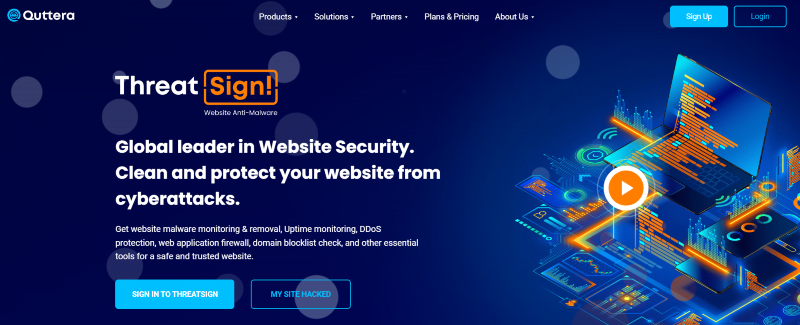
Quttera’s WordPress plugin provides a thorough scanning solution to detect various threats, including malware, trojans, backdoors, worms, and viruses. It employs heuristics and machine learning to identify both known and emerging malware strains. Cloud-based scanning offloads malware detection to remote servers, reducing load on your site’s server. This approach minimises any impact on performance.
However, Quttera is more limited in terms of features compared to some other security plugins, coming without built-in malware removal tools. Many users also report a learning curve when first using Quttera, as the interface and settings may be a tad complex for some users. Pricing starts at $120 per year, with higher tiers including more advanced malware scanning features.
8. ManageWP

ManageWP is not exclusively a security tool – it’s for managing multiple WordPress sites from a single dashboard, and includes malware scanning among its many functions. It’s a popular choice for users overseeing numerous websites, although any malware removal has to be done manually.
Known for its user-friendly interface, ManageWP provides detailed, actionable reporting on security issues. As a cloud-based solution, it has a lightweight footprint, although some users have noted that the service has become slower and less reliable over time. Additionally, storing all site credentials in an external service may raise security concerns for certain users. ManageWP charges $12 per year – per website – for automated malware scanning.
9. Solid Security (Formerly iThemes Security)
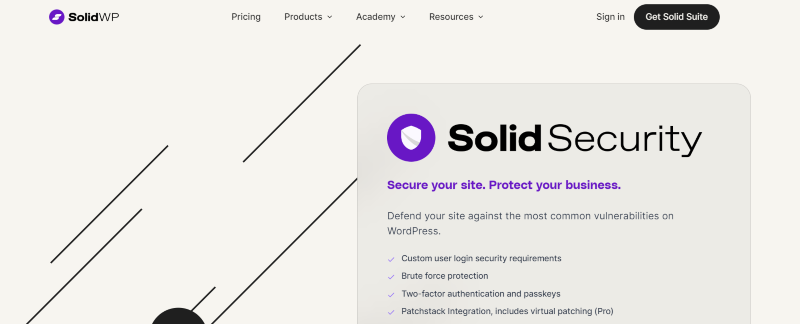
Solid Security – previously known as iThemes Security – is another full-suite plugin that includes a vulnerability scanner among site hardening tools like a firewall and login protections.
Frequently praised for its logical user interface, Solid Security delivers detailed security reports and notifications to keep site owners informed, comparing files to the WordPress core, and scanning plugins, themes, and the database. The tool also integrates with Patchstack for virtual patching if vulnerabilities are discovered during updates.
However, some users consider the scanner less stringent than other dedicated plugins. The plugin can also be resource-intensive, which may cause issues in shared hosting environments. And unlike some other security plugins, Solid Security does not offer any malware removal services, focusing instead on detection and prevention. Solid Security’s Pro version starts at $99 per year for a single site.
How do I choose the right scanner for my website?
With so many WordPress malware scanners available, selecting the best one for your site is no easy task. Consider the following factors when making your choice:
- Real-time monitoring and automatic scanning: Look for a scanner that offers real-time monitoring to catch threats as they emerge. Automatic scanning is also super useful, so your site is regularly checked without manual intervention.
- Compatibility: Ensure the scanner is compatible with your WordPress version and any plugins you rely on. Incompatible scanners can cause conflicts and break site functionality.
- Detailed, actionable reports: The best scanners provide clear, detailed reports that pinpoint issues and offer remediation steps. Avoid tools with vague or confusing reporting.
- User-friendly interface: Choose a scanner with an intuitive interface suitable for your technical skill level. It should be accessible to all users, not just developers.
- Reputation and support: Research the scanner’s reputation on forums and review sites. Opt for well-established tools with responsive developer support and strong community backing.
- Performance impact: Some scanners can slow down your site. Prioritise lightweight, performance-optimised options, particularly if you have limited server resources.
When to scan your site for malware
To keep your WordPress site secure, you should scan for malware regularly – at least once a week, but ideally daily. High-traffic sites or those handling sensitive data may want to run scans multiple times per day. Shield Security PRO defaults to a once-daily malware scan, but you can easily increase the frequency if needed.
Be sure to launch a scan when performing the following tasks:
- After installing new themes or plugins to ensure no malicious code was introduced.
- After updating WordPress core files, plugins, or themes, as these can introduce vulnerabilities.
- If you notice any unusual activity on your site.
Red flags for unusual activity include:
- Unexpected ads or pop-ups.
- Strange page redirects.
- Unrelated search results showing up for your site.
- Unfamiliar admin accounts in your dashboard.
- Google blacklist warnings.
- Abnormally high server usage.
By scanning proactively with tools like Shield Security PRO’s malware scanner, you can catch infections early before they cause lasting damage to your site’s functionality, SEO, and reputation.
Malware detected: What next?
A few things in life are inevitable, and most sites get a dose of malware at some point in their existence. Discovering malware on your WordPress site can be alarming, but a little knowledge goes a long way, and swift action can minimise the damage.
Follow these steps to clean your site and harden it against future attacks:
- Put your site in maintenance mode: This prevents the malware from harming visitors or compromising more data while you work on removing it.
- Back up your site if you don’t have a recent backup: Even if the backup contains the malicious code, it can be a lifesaver if something goes wrong during the cleanup process. ShieldBACKUPS automatically creates secure backups stored separately from your web host, allowing you to easily access a complete backup file that can be used to restore your site to a clean state when necessary.
- Identify the malware source: Use vulnerability scanners to determine how the malware infiltrated your site. Common entry points include outdated plugins, themes, or WordPress core files, as well as weak passwords.
- Remove the malicious code: For simple injections, you can use an automatic repair tool like the one in Shield Security PRO. This replaces the infected file with a clean version from a default WordPress installation. However, be cautious when using automatic repair, as some files may contain custom code that may affect your site’s functionality. In these cases, you’ll need to manually remove the malicious code or hire a professional to do it for you.

- Update all passwords and set up two-factor authentication (2FA): Your site’s login credentials, including WordPress admin, database, FTP, and hosting account, may be compromised. Reset them all to secure your site, and implement 2FA for an extra layer of protection against unauthorised access.
- Update themes, plugins, and WordPress core: Keeping everything up-to-date can patch known vulnerabilities and helps prevent future infections.
- Implement ongoing security measures: Use tools like a firewall, bad bot blocking, and activity monitoring to detect and stop threats before they cause harm.
Stay aware of the state of your site with Shield Security PRO
While malware scanners are an indispensable tool for detecting malicious code on your WordPress site, it’s important to remember that they’re just an initial defensive line. Detection is one thing, but once malware is identified, site admins need to take action to remove it, and address the gateway that allowed it onto their site.
As we’ve seen, there are several reliable malware scanners on the market, so take time to shop around and consider the pros and cons of each. Following our in-depth testing procedure, we recommend Shield Security PRO as the strongest solution out there. Its AI-powered malware detection, insightful reporting, and bad bot-blocking features not only help you find existing malware, but guard against future infections.
Why leave your site’s security to chance? Invest in Shield Security PRO today and enjoy peace of mind knowing your site is protected around the clock.
